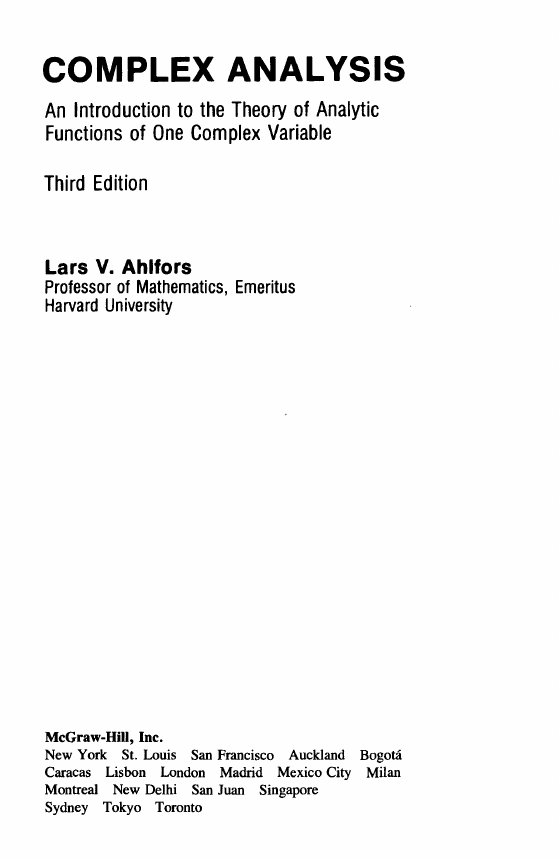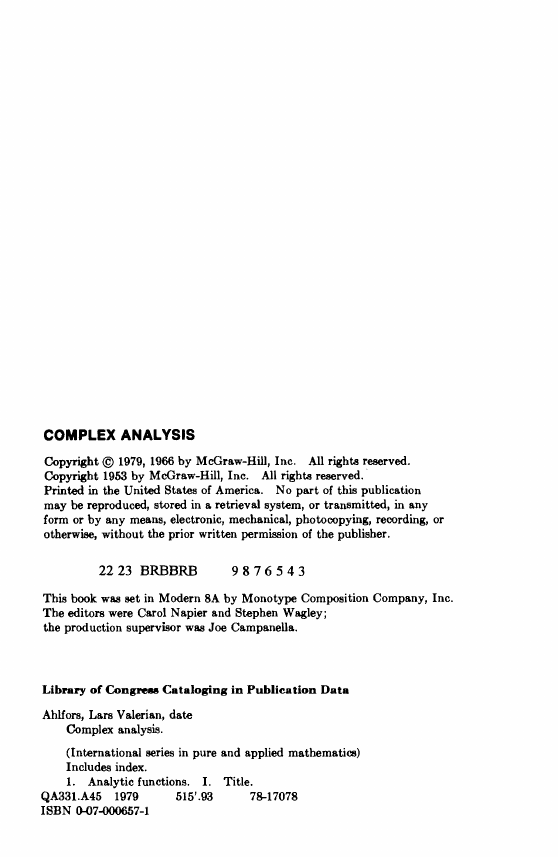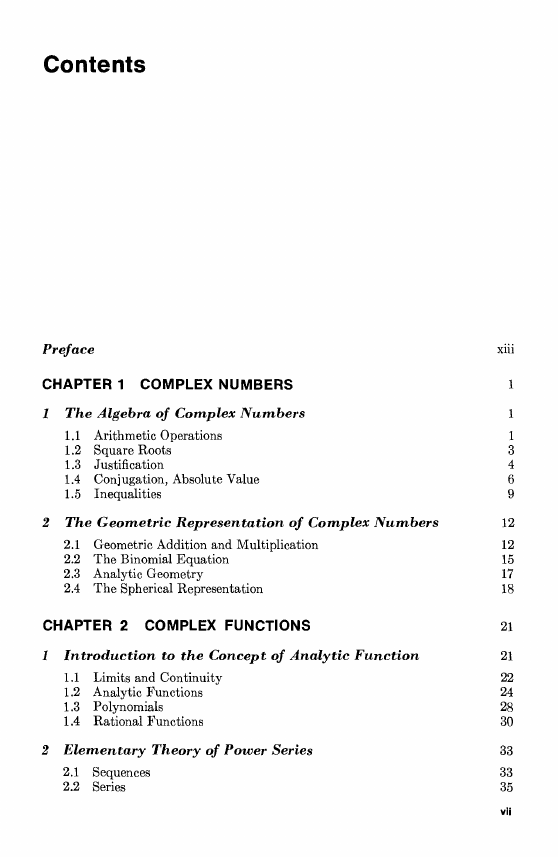Cover
S Title
COMPLEX ANALYSIS: An Introduction to the Theory of Analytic Functions of One Complex Variable, Third Edition
Copyright
© 1979, 1966 by McGraw-Hill
ISBN 0-07-000657-1
QA331.A45 1979 515' .93
Dedicated To Erna
Contents
Preface
1 COMPLEX NUMBERS
1. THE ALGEBRA OF COMPLEX NUMBERS
1.1. Arithmetic Operations
1.2. Square Roots
1.3. Justification
1.4. Conjugation, Absolute Value
1.5. Inequalities
2. THE GEOMETRIC REPRESENTATION OF COMPLEX NUMBERS
2.1. Geometric Addition and Multiplication
2.2. The Binomial Equation
2.3. Analytic Geometry
2.4. The Spherical Representation
2 COMPLEX FUNCTIONS
1. INTRODUCTION TO THE CONCEPT OF ANALYTIC FUNCTION
1.1. Limits and Continuity
1.2. Analytic Functions
1.3. Polynomials
1.4. Rational Functions
2. ELEMENTARY THEORY OF POWER SERIES
2.1. Sequences
2.2. Series
2.3. Uniform Convergence
2.4. Power Series
2.5. Abel's Limit Theorem
3. THE EXPONENTIAL AND TRIGONOMETRIC FUNCTIONS
3.1. The Exponential
3.2. The Trigonometric Functions
3.3. The Periodicity
3.4. The Logarithm
3 ANALYTIC FUNCTIONS AS MAPPINGS
1. ELEMENTARY POINT SET TOPOLOGY
1.1. Sets and Elements
1.2. Metric Spaces
1.3. Connectedness
1.4. Compactness
1.5. Continuous Functions
1.6. Topological Spaces
2. CONFORMALITY
2.1. Arcs and Closed Curves
2.2. Analytic Functions in Regions
2.3. Conformal Mapping
2.4. Length and Area
3. LINEAR TRANSFORMATIONS
3.1. The Linear Group
3.2. The Cross Ratio
3.3. Symmetry
3.4. Oriented Circles
3.5. Families of Circles
4. ELEMENTARY CONFORMAL MAPPINGS
4.1. The Use of Level Curves
4.2. A Survey of Elementary Mappings
4.3. Elementary Riemann Surfaces
4 COMPLEX INTEGRATION
1. FUNDAMENTAL THEOREMS
1.1. Line Integrals
1.2. Rectifiable Arcs
1.3. Line Integrals as Functions of Arcs.
1.4. Cauchy's Theorem for a Rectangle
1.5. Cauchy's Theorem in a Disk
2. CAUCHY'S INTEGRAL FORMULA
2.1. The Index of a Point with Respect to a Closed Curve
2.2. The Integral Formula
2.3. Higher Derivatives
3. LOCAL PROPERTIES OF ANALYTIC FUNCTIONS
3.1. Removable Singnlarities. Taylor's Theorem
3.2. Zeros and Poles
3.3. The Local Mapping
3.4. The Maximum Principle
4. THE GENERAL FORM OF CAUCHY'S THEOREM
4.1. Chains tind Cycles
4.2. Simple Connectivity
4.3. Homology
4.4. The General Statement of Cauchy's Theorem
4.5. Proof of Cauchy's Theorem
4.6. Locally Exact Differentials
4.7. Multiply Connected Regions
5. THE CALCULUS OF RESIDUES
5.1. The Residue Theorem
5.2. The Argument Principle
5.3. Evaluation of Definite Integrals
6. HARMONIC FUNCTIONS
6.1. Definition and Basic Properties.
6.2. The Mean-value Property
6.3. Poisson's Formnla
6.4. Schwarz's Theorem
6.5. The Reflection Principle
5 SERIES AND PRODUCT DEVELOPMENTS
1. POWER SERIES EXPANSIONS
I .1. Weierstrass's Theorem
1.2. The Taylor Series
1.3. The Laurent Series
2. PARTIAL FRACTIONS AND FACTORIZATION
2.1. Partial Fractions
2.2. Infinite Products
2.3. Canonical Products
2.4. The Gamma Function
2.5. Stirling's Formula
3. ENTIRE FUNCTIONS
3.1. Jensen's Formula
3.2. Hadamard's Theorem
4. THE RIEMANN ZETA FUNCTION
4.1. The Product Development
4.2. Extension of t(s) to the Whole Plane
4.3. The Functional Equation
4.4. The Zeros of the Zeta Function
5. NORMAL FAMILIES
5.1. Equicontinuity
5.2. Normality and Compactness
5.3. Arzela's Theorem
5.4. Families of Analytic Functions
5.5. The Classical Definition
6 CONFORMAL MAPPING. DIRICHLET'S PROBLEM
1. THE RIEMANN MAPPING THEOREM
1.1. Statement and Proof
1.2. Boundary Behavior
1.3. Use of the Reflection Principle
1.4. Analytic Arcs
2. CONFORMAL MAPPING OF POLYGONS
2.1. The Behavior at an Angle
2.2. The Schwarz- Christoffel Formula
2.3. Mapping on a Rectangle
2.4. The Triangle Functions of Schwarz
3. A CLOSER LOOK AT HARMONIC FUNCTIONS
3.1. Functions with the Mean-value Property
3.2. Harnack's Principle
4. THE DIRICHLET PROBLEM
4.1. Subharmonic Functions
4.2. Solution of Dirichlet's Problem
5. CANONICAL MAPPINGS OF MULTIPLY CONNECTED REGIONS
5.1. Harmonic Measures
5.2. Green's Function
5.3. Parallel Slit Regions
7 ELLIPTIC FUNCTIONS
1. SIMPLY PERIODIC FUNCTIONS
1.1. Representation by Exponentials
1.2. The Fourier Development
1.3. Functions of Finite Order
2. DOUBLY PERIODIC FUNCTIONS
2.1. The Period Module
2.2. Unimodular Transformations
2.3. The Canonical Basis
2.4. General Properties of Elliptic Functions
3. THE WEIERSTRASS THEORY
3.1. The Weierstrass rf'-function
3.2. The Functions t(z) and u(z).
3.3. The Differential Equation
3.4. The Modular Function
3.5. The Conformal Mapping by A(r).
8 GLOBAL ANALYTIC FUNCTIONS
1. ANALYTIC CONTINUATION
1.1. The Weierstrass Theory
1.2. Germs and Sheaves
1.3. Sections and Riemann Surfaces
1.4. Analytic Continuation along Arcs
1.5. Homotopic Curves
1.6. The Monodromy Theorem
1.7. Branch Points
2. ALGEBRAIC FUNCTIONS
2.1. The Resultant of Two Polynomials
2.2. Definition and Properties of Algebraic Functions
2.3. Behavior at the Critical Points
3. PICARD'S THEOREM
3.1. Lacunary Values
4. LINEAR DIFFERENTIAL EQUATIONS
4.1. Ordinary Points
4.2. Regular Singular Points
4.3. Solutions at Infinity
4.4. The Hypergeometric Differential Equation
4.5. Riemann's Point of View
Index
Index
















 2023年江西萍乡中考道德与法治真题及答案.doc
2023年江西萍乡中考道德与法治真题及答案.doc 2012年重庆南川中考生物真题及答案.doc
2012年重庆南川中考生物真题及答案.doc 2013年江西师范大学地理学综合及文艺理论基础考研真题.doc
2013年江西师范大学地理学综合及文艺理论基础考研真题.doc 2020年四川甘孜小升初语文真题及答案I卷.doc
2020年四川甘孜小升初语文真题及答案I卷.doc 2020年注册岩土工程师专业基础考试真题及答案.doc
2020年注册岩土工程师专业基础考试真题及答案.doc 2023-2024学年福建省厦门市九年级上学期数学月考试题及答案.doc
2023-2024学年福建省厦门市九年级上学期数学月考试题及答案.doc 2021-2022学年辽宁省沈阳市大东区九年级上学期语文期末试题及答案.doc
2021-2022学年辽宁省沈阳市大东区九年级上学期语文期末试题及答案.doc 2022-2023学年北京东城区初三第一学期物理期末试卷及答案.doc
2022-2023学年北京东城区初三第一学期物理期末试卷及答案.doc 2018上半年江西教师资格初中地理学科知识与教学能力真题及答案.doc
2018上半年江西教师资格初中地理学科知识与教学能力真题及答案.doc 2012年河北国家公务员申论考试真题及答案-省级.doc
2012年河北国家公务员申论考试真题及答案-省级.doc 2020-2021学年江苏省扬州市江都区邵樊片九年级上学期数学第一次质量检测试题及答案.doc
2020-2021学年江苏省扬州市江都区邵樊片九年级上学期数学第一次质量检测试题及答案.doc 2022下半年黑龙江教师资格证中学综合素质真题及答案.doc
2022下半年黑龙江教师资格证中学综合素质真题及答案.doc